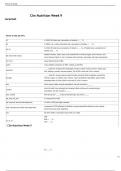8/10/24, 6:09 AM
Clin Nutrition Week 9
Jeremiah
Terms in this set (91)
15 in 1990, NO state had a prevalence of obesity ≥ ___ %
20 in 2008, only 1 state (Colorado) had a prevalence of obesity < ___ %
in 2018, NO state has a prevalence of obesity < ___ %, 47 states have a prevalence of
20, 25
obesity over ___ %
skeletal muscles, water, bone, and essential fat in internal organs, bone marrow, and
lbm (lean body mass)
nerve tissues; higher in men; increases with exercises, decreases with age (sarcopenia)
bmr (rmr) major determinant of LBM
water most variable component of LBM, making up 60-65%
_____ body fat: necessary for physiologic function, stored in bone marrow, heart, lung,
essential
liver, kidneys, muscles, nervous system; 3% of BW in men and 12% in women
_____ body fat: energy reserve under the skin, primarily TAGs in adipose; around the
storage internal organs to protect from trauma, most considered expendable; good health
associated with 18-24% of BW in men and 25-31% in women
size when energy intake exceeds expenditure, fat cells increase in _____
when fat cells have enlarged and energy intake continues to exceed energy
number
expenditure, fat cells increase in _____
size, number with fat loss, the _____ of the fat cells decreses, but not the _____
eat, neat, tef, bmr 4 components of TEE
eat (exercise activity thermogenesis) 15-30% of TEE (but highly variable)
component of TEE affected by lifestyle, energy expended walking to work, typing,
neat (nonexercise activity thermogenesis)
performing yard work, fidgeting
bmr 60-70% of TEE, in starvation drops 15% in 2 weeks
TEE:
BMR = ___ %
67, 10, 23
TEF = ___ %
Clin Nutrition Week 9
AT = ____ %
1/5
, 8/10/24, 6:09 AM
energy needed to support basal metabolism, minimum amount of energy needed to
bee (basal energy expenditure)
sustain bodily function in a waking state, usually about 60-75% of TEE
the amount of energy it takes for your body to digest, absorb, and metabolize the food
tef (thermic effect of food)
you eat
indirect calorimetry estimate of energy expenditure during rest, gives us RQ
rq CO2 produced / O2 consumed
RQs:
_____ = 1.0
carbs, fats, protein
_____ = 0.71
_____ = 0.83
ob, adiponectin 2 genes that can contribute to being overweight/obese
RQs
1.0-1.2 = _____
1.0 = _____as fuel
overfeeding, carbs, fat, alcohol 0.85 = mixed diet of carbs, proteins, fats
0.71 = _____ as fuel, underfeeding, high urinary glucose excretion
0.67 = heavy ___ intake
<0.67 or >1.3 = invalid results
drugs:
_____ = diabetes
victoza, lipitor, altace, advair _____ = high cholesterol
_____ = HTN
_____ = asthma
obesity due to less food preparation at home, lack of activity, increased TV
obesigenicity viewing/gaming, reliance on cars, curtailed PE in schools, availability of energy dense
nutrient poor larger portion foods
the decine in pleasantness with a food as it is eaten relative to a food that has not been
sensory specific satiety
eaten
if one or both parents were obese, probabiltiy of offspring being overweight increased
25-30
by ___ %
genetic, environment BMI is based on _____ factors (50-90%) and ____ factors (10-90%)
gene that may stimulate excessive food intake and reduce the feeling of satiety; 44-
fto (fat mass and obesity) 65% of people estimated to have at least one copy, physical activity can reduce the
influence of the gene on obesity risk
proposes that a gene (or genes) causes people to be energetically thrifty; people with
thrift gene theory this gene expend less energy at rest than other people at rest; protects from starvation
during times of extreme food shortages
suggests that BW stays within a narrow range, compensates for changes in energy
set point theory
balance and keeps a person's weight at their set point
theory states that overeating dietary fat promotes storage as adipose tissue; however
composition of diet overeating carbs or proteins will also lead to weight gain (overconsumption of any
macronutrient can encourage weight gain)
relatively low metabolic rate, low level of spontaneous physical activity, abnormally low
metabolic factors
level thyroid hormone
as you age, your body composition changes:
increased, decreased, decreased _____ body fat
_____ muscle mass atrophy (sarcopenia)
Clin Nutrition Week 9 _____ metabolism
2/5




